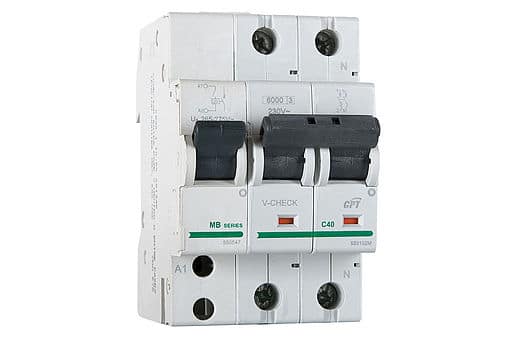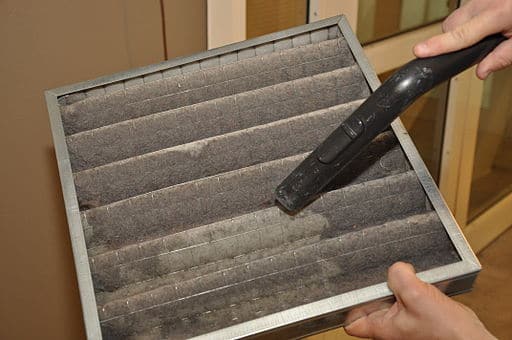It’s a fairly common occurrence for air conditioner technicians to get calls about the AC unit not turning on. But for you, it’s a really frustrating situation, with the summer heat and humidity turning everyone in your family cranky.
Don’t worry, by the end of this article you’ll know all the ways to troubleshoot the problem when your air conditioner doesn’t turn on.
You might be able to rectify some of the faults yourself, but for any issues with internal components, we recommend letting a professional handle it. Let’s dive straight into what you need to know.
Check the Circuit Panel
One of the first things to check is whether a fuse has blown or circuit breakers have tripped due to an overloaded circuit. The panel is a gray box that may be located in the basement, garage, laundry, or in a utility room if you have one. It may also be located outside the house.
Circuit Breakers
Look for one or more circuit breakers that is either in the ‘Off’ position or ‘Neutral’ (halfway between the ‘On’ and ‘Off’ position). Before turning breaker back on, you should first turn off lights and extra appliances in the room where the breaker tripped, to avoid overloading the circuit again. In order to restore power to the circuit, move the breaker to the full ‘Off’ position, and then move it to the ‘On’ position. In case the breaker trips again immediately or after several minutes, you should not reset the breaker again, but call a professional for help.

It might be hard to see that the breaker is in the neutral position sometimes. If you’re unsure, there’s usually a little “give” to it when you touch – you can easily move it back and forth. In “off” or “on” it requires a firm switch.
Fuses
They’re not that common in newer homes, but some of you might have fuses instead of breakers. Or there could be a combination of the two if an upgrade was made at some point.

If all the breakers are ‘On’ then check if your electrical panel has fuses. Look for fuses that have blown; you’ll recognize them by a melted piece of metal inside them or a discolored glass window at the top of the fuse. After identifying the broken fuse, just unscrew it and replace it with another fuse having the same specifications. You might need to take the blown fuse with you to the hardware store to ensure the exact match for size, type and amperage.
The next step after checking the electrical panel is to check the power socket where the AC is plugged in. Sometimes, the plug or socket is faulty, and your AC cannot turn on due to not getting a power supply. Once you’ve verified that the socket is not at fault, move to the next item.
Reset Your System
Supposing there are no issues with the power supply to the AC unit, you should check if there is an emergency switch that was turned off. Turning it on again should take care of the problem.
There should be an on/off switch on the outdoor AC unit near the compressor. Check whether it is off and try turning it on; this may resolve the issue.
If that doesn’t work, consult the appliance’s user manual to see if there is a reset button. Follow the instructions to reset the device or try switching the unit off for five minutes, then restart.
Check the Thermostat
Many AC problems that are not related to electrical issues or the wiring of your home can be traced back to the thermostat. The thermostat of an air conditioning unit plays a key role in ensuring the system functions properly. Without it, many air conditioner systems won’t know whether to turn on.

A faulty thermostat may cause the AC system to randomly switch on and off. A variety of issues can impact the thermostat, including that the AC is not set to ‘cool’, it is set to a high temperature, the unit’s batteries may be dead, or the thermostat is faulty.
Thermostat Temperature Setting
In case the thermostat is set to warm or heat, it won’t turn on. Try turning the thermostat to ‘cool’ and setting the temperature to 5 degrees below the current temperature.
Sensor
You might be able to see the sensor just by opening the thermostat cover. The sensor should be located near the evaporator coil but not touching it. In case the sensor gets dislodged, the solution is to adjust it.
Simply bend the wire that holds the sensor in position. However, the only way to permanently fix a broken sensor or broken thermostat is to replace it because simply repositioning it won’t solve the problem.
Batteries
If the thermostat display is totally blank, check if the battery is dead. Some thermostats have batteries, which you can replace. Other thermostats are wired directly into the mains, so you may have to call a professional to identify the problem.

After you carefully remove the plastic faceplate, you will be able to see the circuit board and maybe some batteries. Try changing them – making sure you put them in the right direction, of course.
After closing up the plastic cover, turn the switch to ‘On’ or ‘Auto’. It’s a good idea to replace the thermostat batteries once a year, maybe at the same time as the fire alarm.
Faulty Thermostat
If you think that your thermostat is faulty, try turning the A/C on from the main unit, bypassing the thermostat. If the unit will turn on manually, you are likely suffering from a thermostat problem. In such cases, your best bet is to call in a professional to handle it.
Other Problems to Check
If you’ve tried all of the above, and none of them work, don’t lose hope! Sometimes a lack of maintenance leads to issues like dirty filters or a clogged drain. We’ll walk you through diagnosing and fixing these issues.
Dirty Filters
A dirty air filter will prevent air from returning to the AC. Reducing airflow over the evaporator coil can cause it to ice up. If the filter is really dirty, a low-pressure switch will trip and shut down your AC’s compressor to prevent it from being damaged.

First, open up the AC’s return vent and remove the filter. You’ll know it’s dirty if you can’t see light through it. Change the filter if it’s disposable, or clean it thoroughly with water and dry it. Your air filters should be changed every 3-4 months, and more frequently if you have shedding pets or a large household.
Coolant
The air conditioner contains refrigerant or coolant, which is a gas. In case of leaks or holes in the system, the gas leaks or seeps out over time. You’ll need a professional to visit and check the refrigerant levels and if needed, to add more refrigerant to the system. The professional may use dye-colored refrigerant to locate and plug up the leaks.
Condensate Drain
In the course of the normal operation of an air conditioner, the condensation which forms on the cold evaporator coil is evacuated via the condensate drain line. But if the drain line gets clogged, the water overflows and a drain float switch will shut down your AC to prevent any water damage.
If you think this might be the reason your AC is not turning on, use a wet/dry vacuum to clean the drain. Locate the main condensate drain line and connect the wet/dry vacuum’s hose to the condensate drain line, then turn it on to suck out any obstructions. Wait around three minutes to ensure that the drain line is clean.
Bad Compressor
In some cases, the air conditioner compressor/motor stops working, which will prevent the air conditioner from turning on. Get a professional to examine the wiring leading to and from the condenser unit. If the motor needs expensive repairs, you might be better off replacing the unit entirely rather than getting it repaired only to have it break down again.
Clean the Outdoor Unit
If the outdoor unit is clogged with leaves or other debris, it may lead to problems such as the hot air flowing indoors instead of outside. Similarly, if the fan is not working, you may hear noises like tapping, scraping, etc. You can clear up the outdoor unit by removing any objects that may be stuck inside. In serious cases, such as burning smell from the unit, you should call in a professional.

It’s a good idea to trim back trees, and of course weeds and grass, from around the unit. Don’t let it get crowded with vegetation. When you mow the lawn, it’s a good idea to sweep off the unit so the clippings don’t stick inside the vents.
In case you notice ice on the unit, the unit may be frozen. This is usually due to poor airflow or bad refrigerant pressure. To find out more ways to troubleshoot a frozen air conditioner, you can see our article here.
What’s Next
Once you’ve tried diagnosing the problem, you might not be able to find the fault and the AC still won’t turn on. If the issue is not in the list above, you might not be able to fix the air conditioner yourself. It’s time to call in a professional to take a look.
Remember that electricity is dangerous and to be cautious while working with electrical appliances and especially with the house wiring and circuits. Make sure your hands are dry and always stand on a dry insulator when handling circuit breakers and fuses.
If you’ve replaced the fuse or reset the breaker and the fuse blows again within a short time, keep the AC and other affected appliances off and get a professional to check the circuits. The problem may result from exposed wiring or a short circuit, so it’s best to let them handle it.
Conclusion
As you can see, there can be quite a few causes for your AC not turning on. Ranging from something simple like cleaning and replacing your filters to getting the compressor repaired, you now know how to methodically eliminate each possibility and get your AC turned on again.
If you are uncomfortable at any step of the troubleshooting, or are feeling overwhelmed, just call in a professional to handle the problem. A professional HVAC contractor can determine the exact nature of your AC trouble and fix it.
